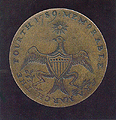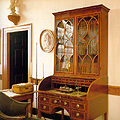 |

5. Table (Leg)
|
 |


5. TABLE (LEG)
Symbolic:
 |
 |

George Washington medal, engraved with the Great Seal of the United States, 1793
National Portrait Gallery,
Smithsonian Institution
|
The table and chair in the portrait probably never existed; they serve only as symbols. The furniture’s neoclassical decorative elements are derived from the Great Seal of the United States, authorized by Congress in 1782. Like the eagle on the Seal, the two eagles at the top of the table leg are posed upright. Each holds in one claw a bundle of arrows, a symbol of war. But unlike the eagle on the Great Seal, neither holds an olive branch, the symbol of peace, in the other claw.
 |
 |

Commemorative button worn at Washington’s inauguration in 1789
Library of Congress
|
The wooden mace in the House of Representatives may have inspired the design for the table leg. That mace (destroyed when the British set the city of Washington afire in 1814) was described as a bundle of reeds tied together and topped by an eagle. A similar object was carried by officials in ancient Rome as a sign of power. A version of it, looking more like a torch, appears on today’s dime.
Biographic:
 |
 |

Inauguration of Washington at New York by Amos Doolittle
Winterthur Museum, Photograph ©
Winterthur Museum
|
The Great Seal of the United States, authorized by Congress in 1782, is older than the Presidency. George Washington was inaugurated as the nation’s first President on April 30, 1789 after unanimous election by the Electoral College. (Framers of the Constitution chose this system rather than a direct popular election.) The Electoral College, again unanimously, elected him to a second term. He declined a third term.
 |
 |

Washington’s presidential desk chair and a Tambour secretary made for
Mount Vernon
The Mount Vernon
Ladies’ Association
|
Washington’s Mount Vernon and its furnishings were well known to many Americans. George and Martha Washington entertained some 2,000 guests there during one seven-year period. The house was frequently portrayed in drawings and became part of his legend. Historians see Washington’s taste in furniture and design reappearing at the turn of the 20th century in the Colonial Revival movement. Particularly popular were pieces linked to Washington. One, a tall chest of drawers, was known as the George Washington Highboy.
Artistic:
 |
 |

Display of the United States of America by Amos Doolittle, engraving, celebrating the Constitution and the new federal government
National Portrait Gallery, Smithsonian Institution
|
Stuart’s use of allegory in this painting was described in an advertisement for the exhibition of a version of the full-length portrait in New York City in 1798. Washington, says the advertisement, “is surrounded with allegorical emblems of his public life in the service of his country.” The advertisement also calls Stuart “the greatest painter of his age.”
 |
 |

George III by William Dickinson and Thomas Watson, mezzotint
National Portrait Gallery, Smithsonian Institution
|
Stuart relied on European precedents for the composition of the portrait. Art historians can point to several earlier European examples in which the subject stands next to an elaborate table.
|




